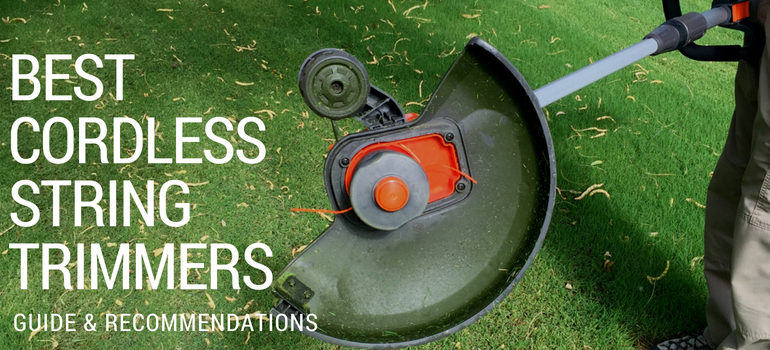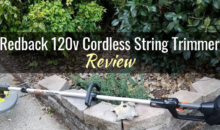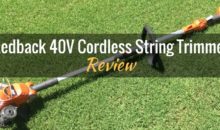Best Cordless String Trimmers / Weed Wackers: Reviews & Buying Guide
We independently evaluate all recommended products and services. If you click on links we provide, we may receive compensation.
Also called weed wackers, weed eaters, grass trimmers (and sometimes even lawn edgers), cordless string trimmers have come a long way over the last few years, going from cumbersome tools that ran out of battery power quickly to the new lightweight, nimble grass cutting machines that provide almost as much “oomph” as a corded or gas powered weed wacker.
As performance has improved, there’s also been an increase in the number of brands competing for your lawn care dollars, including some you may not have heard of before.
Given the plethora of string trimmer models, brands and features available today, how do you choose the best one to meet your needs?
In this article, we review the features to consider when buying a cordless string trimmer so that you’ll know what to look for in choosing a quality product.
If you’re just interested in the different types of trimmers and our recommendations for the best battery powered models, scroll down to the Buying Guide.
>> See our FAQs About Li-Ion Batteries
About Cordless String Trimmers
The best cordless electric string trimmers have a distinct advantage over both gas and corded alternative of the past: they’re light, portable, affordable to run, and easy to take to each and every corner of your garden. There is no gas or oil to mix and pour, and carburetors to clean out. They also differ from their counterparts in a few ways.
Pros and Cons of Cordless String Trimmers
In many respects, cordless grass trimmers are similar to gas-powered and electric versions – they have a handle, shaft, cutting head/motor and string dispenser. The biggest difference is that cordless models run on batteries, but there are a few other differences to be aware of.
Pros
Convenience – Just push the “on” button and start whacking weeds. How much easier could it be? There’s no need to buy gas and then carefully mix it with oil before pouring it into the fuel tank. Nor do you need to buy a long extension cord, plug it in and then drag it all over the yard. Cordless trimmers also require less maintenance than gas-powered ones and don’t give off noxious fumes. And some models even fold up or collapse to make them easier to store.
Portability – Cordless weed eaters can go anywhere you want them to. Without the cord, there’s no need to stop, unplug and switch from outlet to outlet. Plus, most are lightweight, making it easy to carry them wherever they’re needed.
Quietness – Most cordless battery-powered grass trimmers operate below 80 db, meaning that they don’t require ear protection during use. Aside from the trimmer heads whirling and the string(s) slicing through grass and weeds, there’s virtually no noise. Still, we recommend that you use ear protection while using any kind of power equipment – prolonged exposure to louder noises isn’t a good thing.
Cons
Less Power – Unless you choose a high enough voltage model, you might not have as much power as you would with a gas powered grass trimmer. For most uses, this isn’t an issue. But when dealing with longer grass and tougher weeds, that extra power comes in handy.
Shorter Run Time – Battery-powered string trimmers can only run as long as the battery has a charge. When it runs out, you have to put it back on the charger for a while (which is why we recommend having two or more batteries).
Pricier – Most of the time, the best cordless string trimmers will cost more than a standard gas powered model. Then again, you don’t have the cost of gas, oil and engine maintenance so the somewhat higher initial purchase price may be offset those ongoing expenses.
Important Considerations When Buying a Cordless String Trimmer
The best model for you is one that meets your unique needs. Don’t be swayed by all the bells and whistles, glowing reviews or reports of “gas-like performance” – look for something in your price range that’s comfortable for you to use and will handle the kind of work you need it to do.
Yard Size
Most property owners don’t need an expensive, professional-grade string trimmer. In fact, one of the newer battery powered grass trimmers will probably do the job just fine for the majority of urban and suburban yards. But if you’ll be doing a lot of trimming, you may be better off with a gas-powered model.
Weight
You’ll bear the full weight of a string trimmer, so it’s important to select one that’s comfortable to carry and maneuver around your yard. Shoulder straps are available for some models to help carry the burden but if it’s too heavy it could cause shoulder strain.
Battery Life
Cordless string trimmers are powered with a lithium ion battery and typically run for between 15 to 60 minutes of continuous use. Once discharged, the battery will need to be recharged – depending on whether or not you have a fast charger (often an upsell), recharging will take from 30 minutes to about 2 hours.
To avoid waiting while the battery recharges, I recommend investing in an extra battery or two, especially if you have a larger yard or run multiple tools with the same battery.
While lithium ion batteries don’t have a “memory,” they do slowly drain over time, especially if they’re left on the string trimmer (even if it’s off). We recommend removing the battery from the trimmer when not in use and, if you can, storing it indoors. If it’s been a few weeks since you last used it, you’ll probably need to recharge it.
Finally, lithium ion batteries do have a finite lifespan – most will last about 3 to 5 years before they need to be replaced.
Interchangeable Batteries
Most batteries these days are designed to be used interchangeably with other cordless tools from the same manufacturer and with the same voltage. Check to see what other devices are available from the manufacturer that would be compatible with the battery in the string trimmer, such as leaf blowers, chainsaws and pole saws.
Battery Voltage and Amps
High-voltage batteries will give you more power. The more power it has, the tougher the jobs it can tackle.
Comfort & Adjustability
If the trimmer isn’t comfortable to use, or doesn’t fit you well, then you’re unlikely to use it. So look for one that has an adjustable handle, shaft length, and cutting head angle.
Be sure the controls operate smoothly and are easy to reach when using the trimmer.
String Feed System and Reloading
String trimmers have one of two systems for feeding string to the trimmer: bump-feed (tap the head on the ground and more string is delivered) and automatic-feed (as string breaks off, more is automatically fed out of the spool). Both systems are fine, as long as the line is delivered smoothly as it’s needed. Look for a model with a spool that’s easy to replace or load with new line.
If you need to take down unruly weeds and tall grass, look for a string trimmer that’s equipped with dual nylon lines. Lines that are .08 inch or thicker allow you to cut through tougher vegetation.
String Cutting Path
Look for a grass trimmer with a cutting path wide enough to clear large areas with each sweep, yet narrow enough for you to use the trimmer in tight spaces. The average cutting path is 12 inches wide. A 10-inch trimmer will do the job but it’ll take longer if you have more area to cover.
Balance
A good string trimmer, whether it’s gas-powered, corded or cordless, should feel balanced in your hands when held in the cutting position, with the weight evenly distributed from top to bottom or slightly heavier at the top. If most of the weight is in the cutting head, you’ll have a hard time holding it steady and will become quickly fatigued. Models with a top-mount motor generally have better balance than those with the motor near the cutting line.
Variable Power Output / Speed
Some models allow you to vary the speed at which the head/string spins – lower speed for light-duty weed whacking and higher speeds for tougher weeds or long grass. You’ll typically find cordless trimmers with speeds in the 5000 to 9000 RPM range. Keep in mind that higher speed (RPM) will drain the battery more quickly.
Straight vs. Curved Shaft
In terms of performance, there isn’t much difference between these two styles of string trimmer. Ultimately, the choice usually comes down to which model you find most comfortable to use.
Models with a curved shaft tend to be lighter and easier to handle. Models with a straight shaft offer a longer reach, they tend to be better for tall users and for reaching beneath bushes and other shrubs, they they put a greater distance between you and the debris flung up by the trimmer.
Safety First
String trimmers can kick up debris, often in unpredictable directions. While the shield at the bottom of the string trimmer is meant to protect users from flying debris, always wear safety glasses, gloves, long pants, and boots. And, although cordless trimmers are quieter than other models, we still recommend that you wear hearing protection.
Also, look for models in which the starter switch is protected (e.g., a trigger lock) so you can’t accidentally start the string trimmer.
Highly Recommended Cordless String Trimmers
Below are the battery-powered trimmers that we most recommend.
Note that there are different classes of weed eaters represented in the table below – for example, the 120v models are closer to a professional grade tool, while the 20v and 40v units are more lightweight. We compare tools within their relevant class when determining ratings (so, for example, we’re not comparing a 20v vs a 120v tool).
Not Recommended Cordless String Trimmers
We’re currently testing more cordless string trimmers so come back soon for additional recommendations and detailed reviews.
Last update on 2024-04-27 / Affiliate links / Images from Amazon Product Advertising API
Enjoyed This Review?
If you liked this review, please sign up for our email updates with reviews, how-to articles and gardening videos!












Where do I find ‘generic’ replacement batteries? I can purchase a new DR portable string trimmer for LESS than a battery from DR! A source for replacement batteries – other than the mfg – would be appreciated
It’s frustrating Tim, but pretty common to find batteries costing more than if you bought a whole new tool complete with batteries. I generally look on Amazon first, although that’s not always going to get you a reasonably-priced replacement battery. There are a bunch of discount sellers online, although they tend to sell the major consumer brands for construction tools, like Milwaukee, Bosch and Porter Cable, rather than the brands you typically find in the gardening tools space. Overall, I’d say just keep Googling until you find something. Sorry I can’t give you a more satisfying answer.
I really enjoyed reading your Article, very enlightening. Thanks for sharing
Hi Kahuthia,
We’re glad you enjoy reading our reviews, and thankful that you do so. Happy gardening!
When will your cordless string trimmer comparison review be finished? I’m researching now
We have a few reviews completed and more underway. So far, these are the best ones we’ve seen –
TroyBilt TB4200
Redback 106065 – We’re also looking at the new 120V version
WORX GT Revolution – We’re currently testing the latest version of this one and it’s very good.
Look for more reviews coming over the summer but for now I’d say you can’t go wrong with any of the ones listed above.